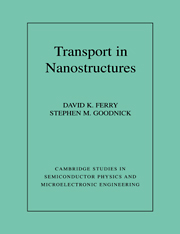2 - Quantum confined systems
Published online by Cambridge University Press: 06 January 2010
Summary
As discussed in the previous chapter, there are two issues that distinguish transport in nanostructure systems from that in bulk systems. One is the granular or discrete nature of electronic charge, which evidences itself in single-electron charging phenomena (see Chapter 4). The second involves the preservation of phase coherence of the electron wave over short dimensions. Artificially confined structures are now routinely realized through advanced epitaxial growth and lithography techniques in which the relevant dimensions are smaller than the phase coherence length of charge carriers. We can distinguish two principal effects on the electronic motion depending on whether the carrier energy is less than or greater than the confining potential energy due to the artificial structure. In the former case, the electrons are generally described as bound in the direction normal to the confining potentials, which gives rise to quantization of the particle momentum and energy as discussed in Section 2.2. For such states, the envelope function of the carriers (within the effective mass approximation) is localized within the space defined by the classical turning points, and then decays away. Such decaying states are referred to as evanescent states and play a role in tunneling as discussed in Chapter 3. The time-dependent solution of the Schrödinger equation corresponds to oscillatory motion within the domain of the confining potential.
The second type of motion we will be concerned with is that associated with propagating states of the system. Here the carrier energy is such that it lies above that of the confining potentials, or that the potentials are limited sufficiently in extent so that quantum mechanical tunneling through such barriers can occur.
- Type
- Chapter
- Information
- Transport in Nanostructures , pp. 23 - 90Publisher: Cambridge University PressPrint publication year: 1997
- 1
- Cited by

